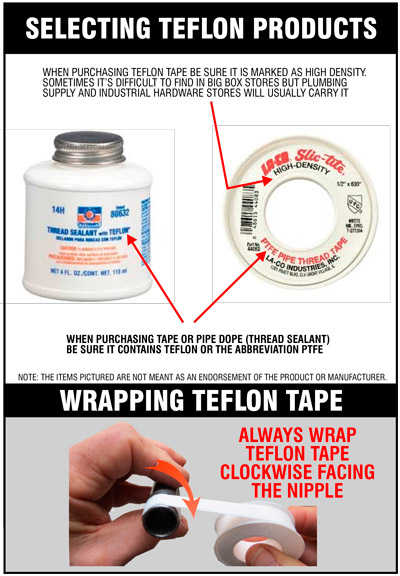Last month was devoted to stopping solvent and vapor leaks by maintaining the gaskets which provide a seal on the various doors of the dry cleaning machine. These gaskets are normally pre-formed (molded) to the precise size and shape required to fit in the door. This month we’re going to cover how to seal areas that do not have pre-formed gaskets or where installing a pre-formed gasket would be difficult and time-consuming.
The two greatest gifts from the god of mechanics were the materials of Teflon and Silicone. We will be using these versatile sealants frequently, in one form or other, in the repairs covered in this and the following articles.
Let’s begin with the KING of gasket material Teflon. Teflon has four wonderful qualities that are especially suited to our industry. First, its temperature range is from -50 F to around 400 F, thus allowing its’ use on the steam piping in a normal dry cleaning/laundry operation. Second, it is chemically resistant to just about anything you can slop on or over it including any of the solvents you may be using, in either a liquid or vapor form. Third, it has self-lubricating qualities, and last but not least it comes in several forms each well suited to a particular leak stopping application. I’ll give a quick list of the types of Teflon, then their uses.
▲ Teflon tape- You are all by now familiar with Teflon in the form of a tape. Teflon tape comes in various flavors for different purposes. I use three different types; a cheap thin ½” wide white-colored for wrapping screws and bolts to keep them from locking up from dirt or corrosion; a dense ½” wide white-colored for wrapping pipe threads up to and including ½”; a yellow ¾” wide for wrapping threads on pipe over ½”. These tapes not only act as a sealant, also Teflon’s’ self-lubricating qualities allow the pipe to screw into the fitting without “galling”; meaning friction grinding metal chips off the pipe and fittings, freezing up the assembly before a good seal is accomplished (also galling makes it impossible to disassemble the pipe and fittings without damage).
▲ Teflon pipe dope- This paste-like material comes in a can with a brush built into the lid. It is used to coat the threads in on pipe and in fitting before assembling these parts.
▲ Teflon string or round packing- Resembling spaghetti this round form of Teflon is used to pack valves and to form seals and gaskets between flanges or other flat surfaces.
▲ Solid Teflon sheeting- this material comes in both a solid and closed-cell foam version. Expensive but at times the only answer for sealing some very difficult leaks at irregularly shaped flanges or uneven, warped, or pitted mating surfaces.
Starting with the use of Teflon tape:
1. For sealing pipe threads- wind at least 3 turns of tape around the circumference of the pipe; it is important to wind the tape in the correct direction which is clockwise when facing the end of the pipe. This distributes the tape evenly and pulls it into the threads when a fitting is screwed onto the pipe (wound in the wrong direction the tape will be pushed out of the threads and bunch up on the outside of the fitting). Use a dense ½” wide white colored tape for wrapping pipe threads up to and including ½”; a yellow ¾” wide tape for wrapping threads on pipe over ½”. For extra sealing reliability use Teflon pipe dope over the tape on the male end of the fitting and in the treads on the female fitting.
2. For preventing nuts, screws, and bolts from freezing together or locking up- wind 2 turns around the threads in a clockwise direction, same as with pipe threads, and pull the tape tight.
4. Creating thin string packing- You will often find small valves leaking at the stems. The shutoff valves at the top and bottom of boiler sight glass fixtures are a perfect example of this kind of leak. After completing the packing procedure and tightening down the packing nut, remember this type of valve seats with the valve completely open. (DO NOT DO ANY MAINTENANCE ON PRESSURIZED OR HOT BOILER!) Compression fittings leaking steam past the compression nut is another common leak of this type. An unusually effective method to stop these leaks is to install extra Teflon packing behind the packing nut on valves, or the compression nut on fittings. You can whip up this packing in a heartbeat by taking a 12-inch length of Teflon tape and holding one end while “spinning” the other end between the thumb and forefinger of the other hand until it forms a soft round string. Then unscrew the leaking nut and slide it up the valve stem or down the copper tubing in the case of a compression fitting nut, hold one end of the string and wind several turns around the valve stem or copper tubing pulling it taught. Now while holding tension on the string push the packing nut or compression nut onto the valve or fitting body and screw it down. The beauty of using Teflon like this is that the nut will cut through the soft Teflon so you needn’t try to cut the ends of the string, losing the tension on the packing in the process.
Well that’s all I’ve got time for this month, next I’ll continue with more gasketing information.

Bruce Grossman
Bruce Grossman is the Chief of R&D for EZtimers Manufacturing. EZtimers is the manufacturer of the new EZ DOSE boiler compound manager and return tank level control which replaces that troublesome ball float valve in the condensate return tank and automatically adds the correct amount of boiler compound to the return tank preventing the oxygen corrosion and scaling. Our SAHARA and DIB-M high purity separator water mister/evaporators provide a thrifty, legal method to get rid of the separator water generated by your dry-cleaning machine. See our Ad in this issue and for further information on EZtimers products visit www.eztimers.com Please address any questions or comments for Bruce to bruce@eztimers.com or call 702-376-6693.
